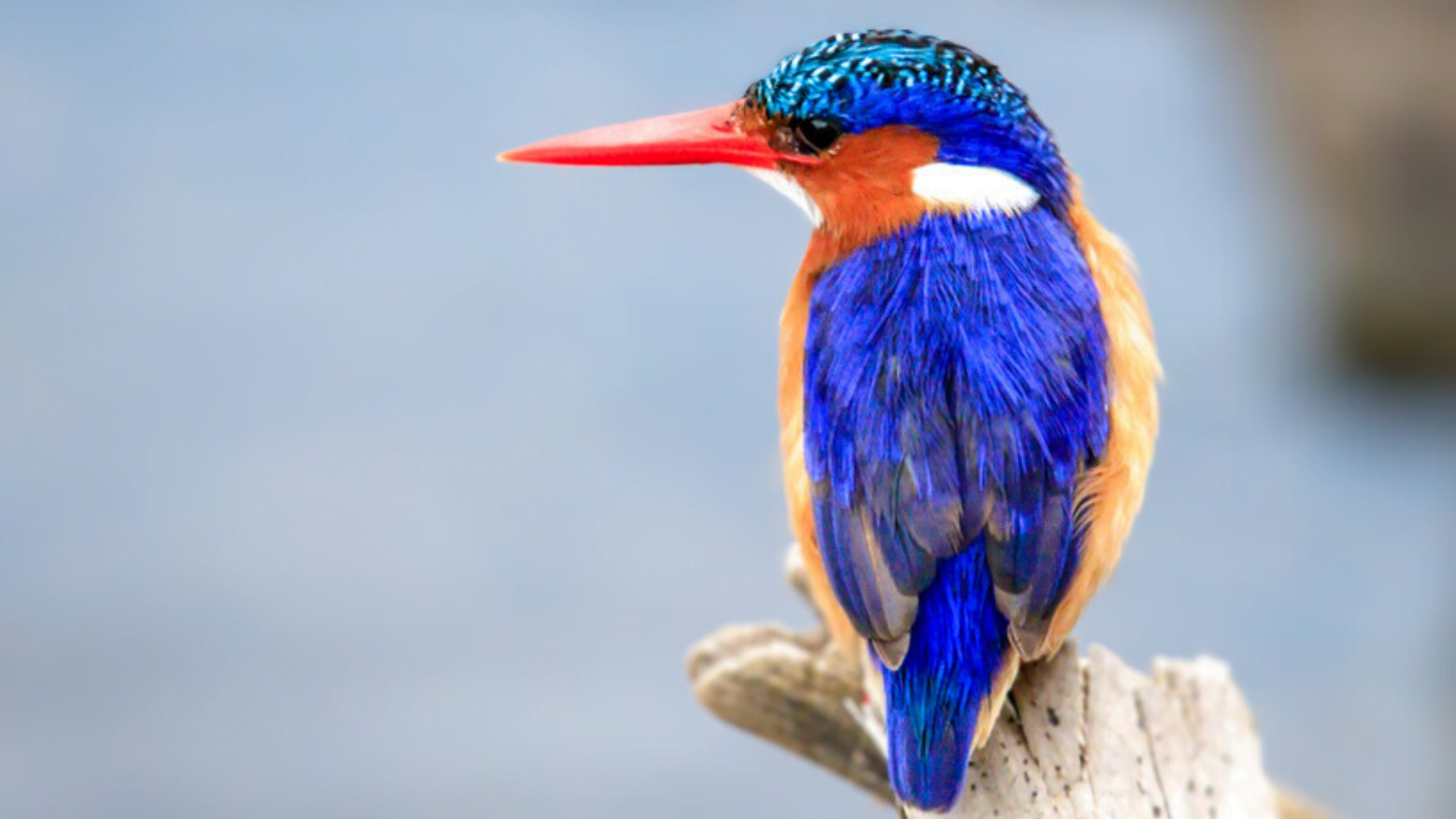Are you interested in learning more about the diverse and enchanting world of African bird species? From vibrant plumage to unique vocalizations, African birds are a truly captivating subject of study. This article will provide a comprehensive overview of African bird species, habitats, migration patterns, and conservation efforts. Whether you’re an avid birdwatcher or simply intrigued by the fascinating world of avian life, this article is sure to be an informative and engaging read.
Throughout this article, we’ll explore the different aspects of African bird life, including their behavior, ecology, identification techniques, and much more. By the end of this journey, you’ll have a deeper understanding and appreciation of the vast array of bird species found in Africa and the importance of protecting their habitats and populations.
African Bird Species and Their Habitats
Africa is home to an incredible range of bird species, from vibrant parrots to majestic eagles. These birds have adapted to a wide variety of habitats throughout the continent, each with their unique characteristics.
The African Grey Parrot is one such species that has adapted to living in the dense rainforests of West and Central Africa. These parrots are highly intelligent and are known for their ability to mimic human speech and sounds.
| Bird Species | Habitat |
|---|---|
| African Fish Eagle | Rivers, lakes, and wetlands |
| Ostrich | Savannas, grasslands, and deserts |
| African Grey Parrot | Rainforests and woodlands |
| Violet-backed Starling | Woodlands, savannas, and gardens |
| African Penguin | Coastal areas and islands |
| Secretary Bird | Grasslands and savannas |
| African Jacana | Wetlands, marshes, and swamps |
The African Fish Eagle, on the other hand, prefers to live near waterways and wetlands throughout sub-Saharan Africa, where it feeds on fish. The Secretary Bird, known for its distinctive silhouette, can be found in open grasslands, savannahs, and semi-deserts of sub-Saharan Africa. Meanwhile, the Hammerkop can be found in wetlands and forests across sub-Saharan Africa.
Other notable African bird species include the Ostrich, the largest bird in the world, which can be found in the savannahs and deserts of Africa; and the Olive Sunbird, a small bird found in the forests and woodlands of East Africa.
Each bird species has its unique characteristics that have allowed them to thrive in diverse habitats across the continent. Understanding the habitat of each bird species can help birdwatchers locate and identify them during their adventures.
African Fish Eagle:

This magnificent bird of prey is known for its distinctive dark brown plumage, white head, and powerful hooked beak. It’s found near rivers, lakes, and wetlands across much of Africa, where it feeds mainly on fish. The African Fish Eagle is an apex predator and is revered in many African cultures as a symbol of strength and power.
Ostrich:
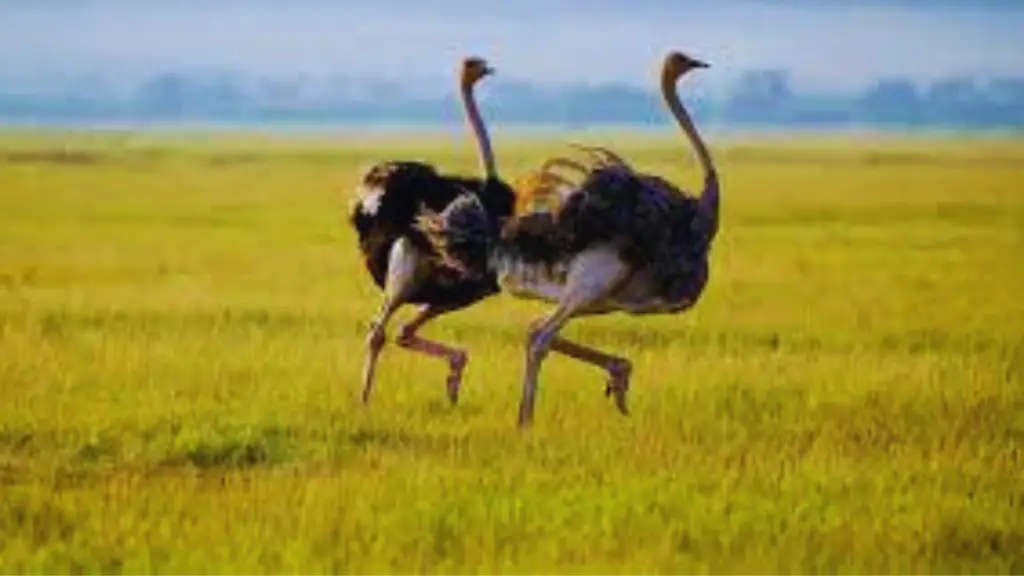
The world’s largest bird, the ostrich, is a flightless bird that’s primarily found in the savannas, grasslands, and deserts of Africa. They’re known for their long necks and legs, distinctive feather patterns, and their ability to run at impressive speeds of up to 70 km/h. The ostrich is an important cultural symbol in many African tribes, and its feathers and eggs are used for various traditional purposes.
African Grey Parrot:

This intelligent and talkative bird is a popular pet species due to its remarkable ability to mimic human speech. In the wild, African Grey Parrots are found in the rainforests and woodlands of West and Central Africa. They feed on fruits, nuts, and seeds and are highly social birds that often form lifelong bonds with their mates.
Violet-backed Starling:

The Violet-backed Starling is a strikingly beautiful bird with iridescent green and purple plumage and a distinctive yellow eye. They’re found in woodlands, savannas, and gardens throughout sub-Saharan Africa and feed on a variety of insects and fruits. The Violet-backed Starling is known for its melodious song, which is often heard in the early morning and late afternoon.
African Penguin:

The African Penguin is a small, flightless bird that’s endemic to the coastal areas and islands of southern Africa. They’re known for their distinctive black and white plumage, pink glands above their eyes, and braying call. African Penguins are social birds that form monogamous pairs and breed in large colonies on rocky shores.
Secretary Bird:
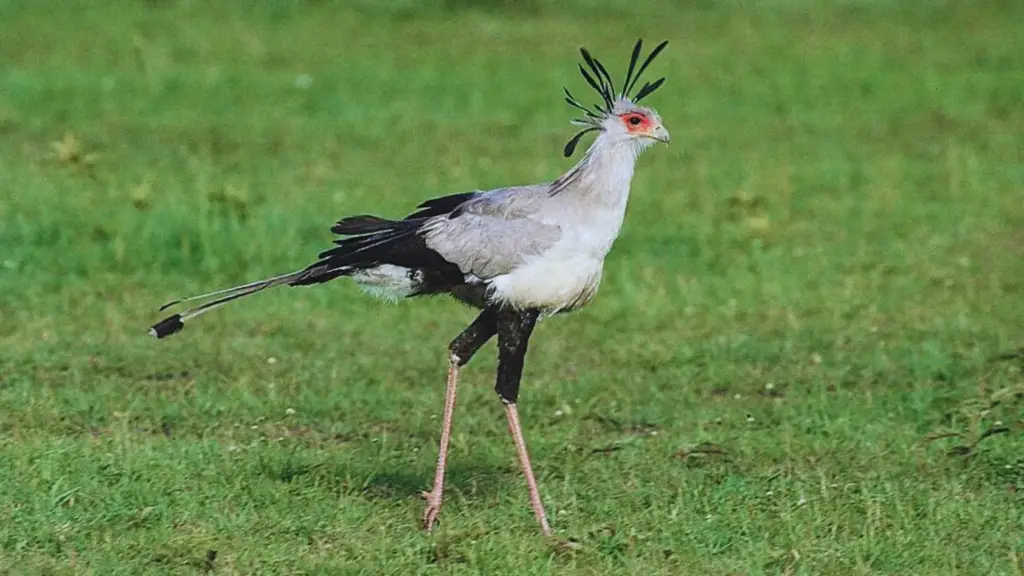
This large, terrestrial bird of prey is found in the grasslands and savannas of sub-Saharan Africa. The Secretary Bird is known for its long legs, distinctive black feathers on its head, and its ability to kill snakes and other prey with powerful kicks from its legs. It’s an important cultural symbol in many African tribes and is often depicted on flags and emblems.
African Jacana:
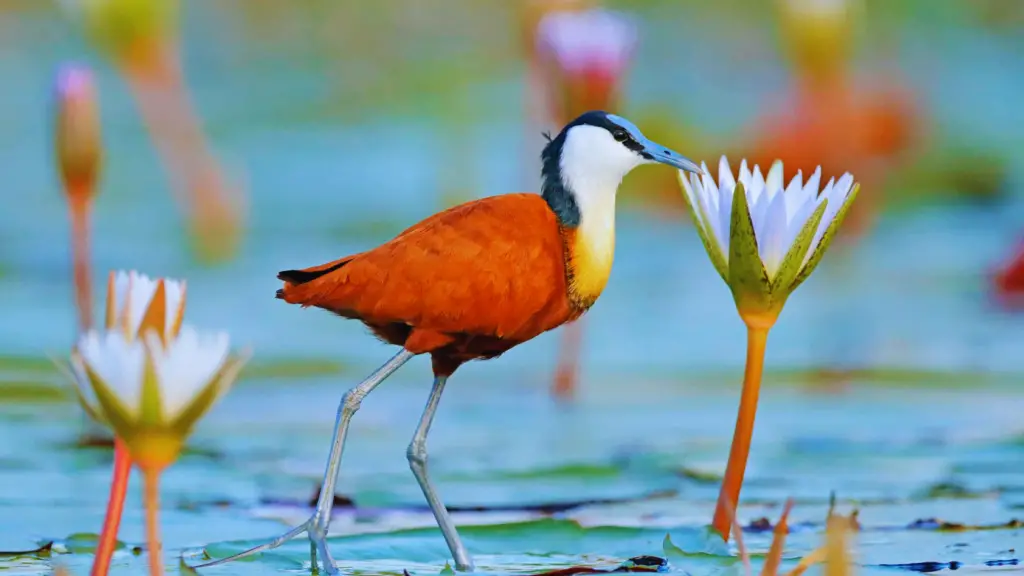
The African Jacana is a small wading bird that’s found in wetlands, marshes, and swamps throughout much of Africa. They’re known for their distinctive long toes, which allow them to walk on floating vegetation, and their bright yellow and brown plumage. African Jacanas feed on insects, small fish, and other aquatic invertebrates and often have multiple mates, with males taking care of the chicks.
African Bird Migration and Patterns
African bird migration is one of the most fascinating natural phenomena in the world. Every year, millions of birds embark on incredible journeys across the continent, covering thousands of miles to reach their destination.
The migration patterns of African birds are complex and diverse, with many species following specific routes to their breeding or wintering grounds. Some birds fly south to escape the cold winter months, while others migrate north to take advantage of the summer breeding season.
African Bird Migration Routes
| Species | Migration Route |
|---|---|
| European Bee-Eater | Europe to South Africa |
| Osprey | Northern Europe and Asia to Southern Africa |
| European Pied Flycatcher | Europe to West Africa |
| Barn Swallow | Europe and Asia to South Africa |
These migration routes are not without their challenges. Birds must contend with changes in weather patterns, survive predators and hunters, and navigate through unfamiliar territory to reach their destination.
Studies have shown that climate change is also affecting the timing and duration of bird migration in Africa. Changes in temperature and rainfall can impact the availability of food and nesting sites, causing birds to alter their migration patterns in response.
Why Do African Birds Migrate?
The reasons behind bird migration in Africa are varied and complex. Some birds migrate to escape harsh weather conditions, while others do so to take advantage of the abundance of food during specific seasons.
For many migratory bird species, breeding is the primary reason for their journey. They migrate to specific regions to mate and raise their young, where conditions are optimal for the survival of their offspring. Once the breeding season is over, they make the return journey to their wintering grounds.
Despite the challenges and risks involved in bird migration, it remains an essential aspect of African bird life. By understanding the migration patterns of birds, we can gain valuable insight into their behavior and biology, as well as the conservation efforts needed to protect their populations.
African Birdwatching: A Bird Lover’s Paradise
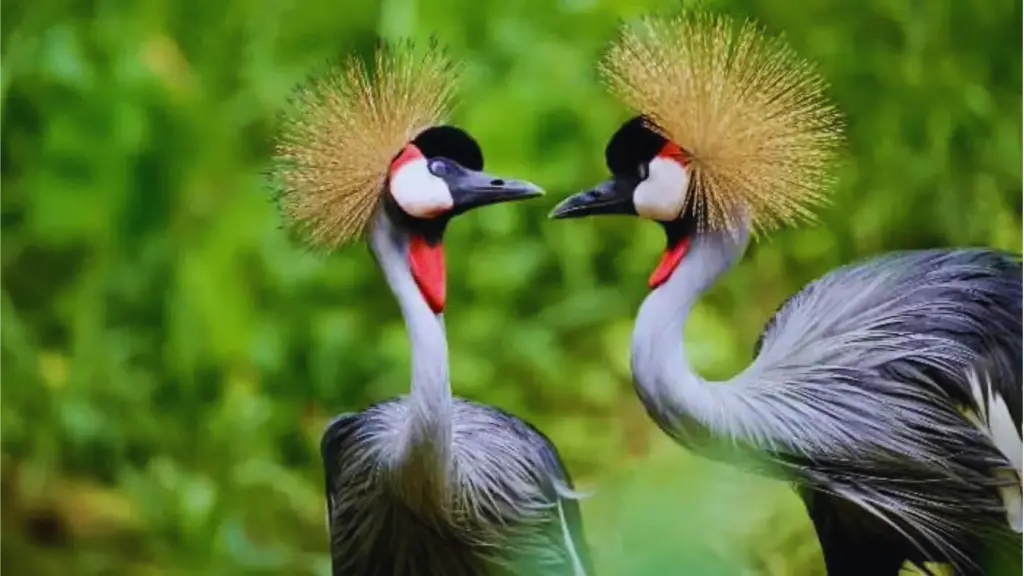
Africa is a birdwatcher’s paradise, home to some of the world’s most diverse and colorful bird species. With over 2,500 species and a variety of habitats, from deserts to forests, savannas to wetlands, Africa offers endless opportunities for birdwatching.
African Birding Tours
Africa has numerous birding tours that cater to bird enthusiasts from all over the world. These tours provide well-planned itineraries that take birdwatchers to top birding hotspots across the continent, such as the Okavango Delta in Botswana, the Serengeti in Tanzania, or Kruger National Park in South Africa. They also provide expert guides with knowledge of the local bird species and their habits, making it easier for birdwatchers to tick off as many species as possible from their lists.
African Birding Destinations
With a variety of habitats, it is no surprise that Africa has several top destinations for birdwatching. South Africa, for instance, has over 800 bird species, including the African Penguin, Blue Crane, and the Southern Bald Ibis. In East Africa, Tanzania and Kenya offer excellent birding opportunities, especially along the Rift Valley region. The Maasai Mara National Reserve in Kenya, for instance, is famous for its bird-rich acacia woodlands and grassy plains.
Why Africa is a Birdwatching Haven
Africa’s varied habitats, which range from deserts to forests, savannas to wetlands, make it a birdwatcher’s haven. The continent is also home to several endemic bird species, species that cannot be found anywhere else in the world. This has made Africa a popular destination for birdwatchers looking to add unique species to their life lists.
Furthermore, Africa’s conservation efforts have led to the creation of several bird sanctuaries and protected areas, ensuring the preservation of bird habitats and the survival of threatened bird species.
Africa’s beautiful landscapes and unique bird species make it an irresistible destination for birdwatchers around the world. With well-planned birding tours and numerous birding destinations, Africa provides an unforgettable birding experience that should not be missed.
African Bird Conservation Efforts
African birds face numerous threats, including habitat loss, climate change, hunting, and exploitation. To combat these threats, many conservation organizations and individuals are working hard to protect African bird species and their habitats.
African bird sanctuaries, such as the Lake Nakuru National Park in Kenya and the Djoudj National Bird Sanctuary in Senegal, provide safe havens for migratory birds and other endangered species. These sanctuaries also offer educational programs and guided tours to raise awareness of the importance of bird conservation.
| Conservation Organizations | Focus Area |
|---|---|
| African Bird Club | Supports bird research, conservation efforts, and education initiatives across Africa. |
| BirdLife International Africa | Works with local partners to identify and protect critical bird habitats in Africa. |
| East African Bird Conservation Network | Focuses on bird conservation in East Africa, providing training and capacity building programs for local communities. |
In addition to these efforts, ongoing research is being conducted to better understand the ecology and behavior of African birds. This research is helping to inform conservation strategies and protect African bird populations for future generations.
If you are interested in supporting African bird conservation efforts, consider donating to a reputable conservation organization or participating in a birdwatching tour that supports local conservation initiatives.
African Bird Ecology and Behavior
African birds are renowned for their unique behaviors and fascinating ecology. From their feeding habits to their vocalizations, every aspect of their behavior is intriguing. Here are some interesting facts about African bird ecology and behavior:
African Bird Feeding Habits
African birds have diverse feeding habits, depending on their species and habitats. Some birds, such as the African fish eagle, feed on fish, while others, such as the Marabou stork, feed on carrion. Others, like the African grey parrot, are omnivores and feed on fruits, nuts, and insects. The African honeyguide is famous for its association with humans in finding beehives, while the Egyptian plover is known for its unique symbiotic relationship with the Nile crocodile, where it feeds on parasites in the crocodile’s mouth.
African Bird Breeding Season
Many African birds have a specific breeding season, which is influenced by the availability of food and other resources. The breeding season is essential for the continuation of the species, and several behaviors are associated with it. For instance, male birds often display their plumage and perform intricate courtship dances to attract females. Some bird species, such as the African pitta, are known for their elaborate nest-building behaviors, while others, like the ostrich, have unique incubation behaviors.
African Bird Vocalizations
African birds are famous for their unique vocalizations, which include calls, songs, and mimicry. The African grey parrot is renowned for its ability to mimic human speech, while the African pied wagtail has a distinctive call that is often used to attract mates. The superb starling is famous for its beautiful singing voice, which often attracts the attention of birdwatchers and photographers. These vocalizations play an essential role in communication, mating, and territorial defense.
African Bird Plumage
African birds come in a range of colors, and their plumage reflects the unique diversity of the continent’s avifauna. Some birds, such as the lilac-breasted roller, have vibrant colors that make them attractive to birdwatchers. Others, like the African penguin, have unique black and white patterns that help them blend in with their surroundings. The plumage of African birds is also critical for camouflage and protection from predators.
African Bird Behavioral Adaptations
African birds have a range of behavioral adaptations that help them survive in their unique habitats. For instance, the flamingo has a specialized beak that filters food from the mud, while the African jacana’s long toes enable it to walk on floating vegetation to find food. The African fish eagle has sharp talons that enable it to capture fish from the water, while the saddle-billed stork has a long, curved bill that it uses to extract snails from their shells. These behavioral adaptations are crucial for the survival of African bird species.
African Bird Identification and Field Guides
Identifying African bird species can be challenging, especially for those who are new to birdwatching. Fortunately, there are many resources available to assist with bird identification in Africa. Here are some tips and field guide recommendations:
Identifying African Birds
When attempting to identify a particular bird species in Africa, it is important to take note of its size, coloration, and any unique markings or features. Pay attention to its behavior, vocalizations, and habitat as well. Careful observation and note-taking can be invaluable when attempting to identify a particular bird.
It can also be helpful to consult a field guide when trying to identify a bird species. Many field guides include illustrations or photographs of different bird species, along with descriptions of their physical characteristics and behavior patterns. Some field guides also include maps of bird distribution and migration patterns.
Recommended African Bird Field Guides
| Field Guide | Author | Description |
|---|---|---|
| Roberts Bird Guide | Hugh Chittenden and Greg Davies | A comprehensive guide to the birds of southern Africa, featuring over 950 species and illustrated with more than 4000 photographs and artwork. |
| The Birds of East Africa | Terry Stevenson and John Fanshawe | A guide to the birds of Kenya, Tanzania, Uganda, Rwanda, and Burundi, featuring illustrations and descriptions of over 1400 species. |
| Birds of Africa South of the Sahara | Ian Sinclair and Peter Ryan | A comprehensive guide to the birds of Africa, featuring over 2400 species illustrated with color plates and distribution maps. |
These field guides are just a few examples of the many resources available for identifying African bird species. Before embarking on a birdwatching adventure in Africa, it is recommended to do research and find a field guide or other resource that suits your needs.
African Bird Photography and Sounds
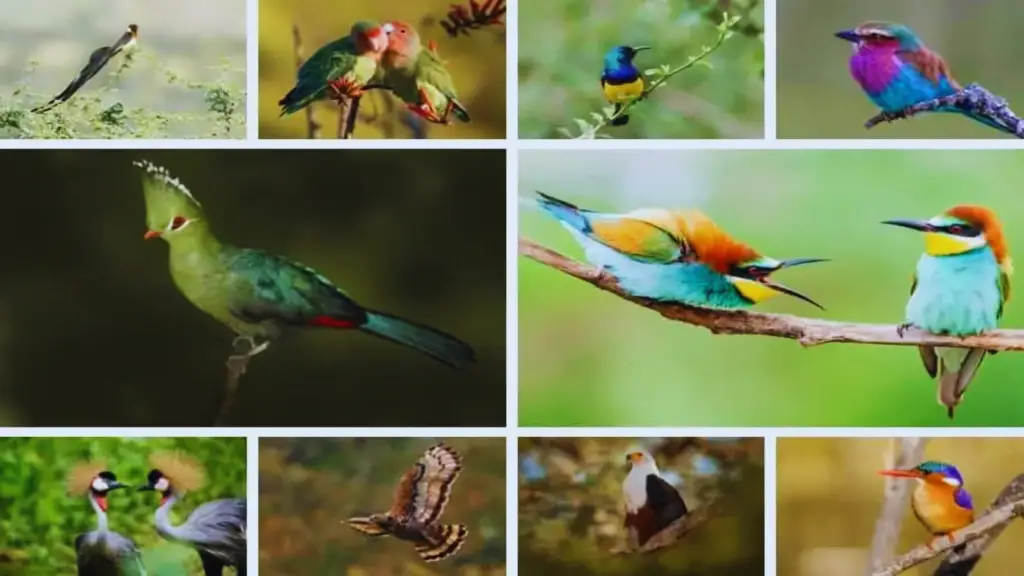
One of the best ways to appreciate the beauty of African birds is through photography and sound recordings. Capturing stunning bird photographs requires patience, skill, and the right equipment. Likewise, recording the unique vocalizations of African birds can provide valuable insights into their behavior and ecology. Here are some tips and techniques for capturing the sights and sounds of African birds:
African Bird Photography
1. Use the right gear: For bird photography, you need a high-quality camera with a fast shutter speed, a telephoto lens, and a tripod. This equipment will allow you to capture sharp, detailed images from a distance without causing disruptions or harming the birds in their natural habitat.
2. Get close: Try to get as close to the birds as possible without disturbing them. This may require waiting patiently for them to come closer or using camouflage techniques to blend in with your surroundings.
3. Use natural lighting: The best time to shoot bird photos is early in the morning or late in the afternoon when the light is softer and warmer. Avoid using flash, which can startle the birds and alter their behavior.
4. Choose your composition carefully: Consider the lighting, the background, and the bird’s position and posture when taking your shot. Try to frame the photo in a way that emphasizes the bird’s unique features and personality.
5. Be respectful: Always treat the birds and their environment with respect. Do not disturb their nests or habitats, and avoid making loud noises or sudden movements that may frighten them.
African Bird Sounds
1. Use high-quality equipment: To record bird sounds, you need a good-quality microphone and a digital recorder. These tools will help you capture clear, detailed recordings of the birds’ calls and songs.
2. Choose your location carefully: Go to a quiet, isolated spot where you can hear the birds without interference from other sounds. Try to record in the early morning or late afternoon when the birds are most active and vocal.
3. Pay attention to the birds’ behaviors: Observe the birds’ movements, postures, and interactions to gain a deeper understanding of their vocalizations. Some birds have complex songs and calls that are used for mate attraction, territorial defense, or other social purposes.
4. Use editing software: Once you have recorded the bird sounds, you can use editing software to clean up the audio and enhance its quality. This will help you isolate the different elements of the birds’ songs and calls and analyze them more closely.
African birds are a feast for the senses, offering a vibrant palette of colors, behaviors, and sounds. By using the right equipment and techniques, you can capture these moments and preserve them for years to come.
FAQs about African Birds Species
Here are some frequently asked questions and their answers regarding African birds:
What is the most common African bird species?
The most common African bird species is the Red-billed Quelea, which is found in large flocks across the continent.
Are all African birds brightly colored?
No, not all African birds are brightly colored. Some, like the African Fish Eagle, have more muted plumage, while others, like the Tawny Eagle, are primarily brown.
What is the best time of year for birdwatching in Africa?
The best time for birdwatching in Africa depends on the region. Generally, the dry season is better for birdwatching as the lack of foliage makes it easier to spot birds. For East Africa, this would be from June to September, and for Southern Africa, from May to October.
How can I participate in African bird conservation efforts?
There are many ways to participate in African bird conservation efforts. You can donate to organizations that work to protect African birds and their habitats, volunteer at bird sanctuaries, or simply spread awareness about the importance of protecting these species.
Do African birds have any predators?
Yes, African birds have many predators, including larger birds of prey like eagles and hawks, as well as ground predators like snakes and mammals.
What is the difference between endemic and non-endemic African bird species?
Endemic African bird species are those that are only found in certain regions of Africa, while non-endemic species can be found in multiple regions or even across the entire continent.
Can African birds mimic human speech?
While some African birds, like the African Grey Parrot, are known for their remarkable ability to mimic human speech, most African bird species do not have this ability.
How long do African birds typically live?
The lifespan of African birds varies depending on the species. Some birds, like the Lappet-faced Vulture, can live up to 45 years, while others, like the Red-billed Hornbill, only live for around 8 years.

